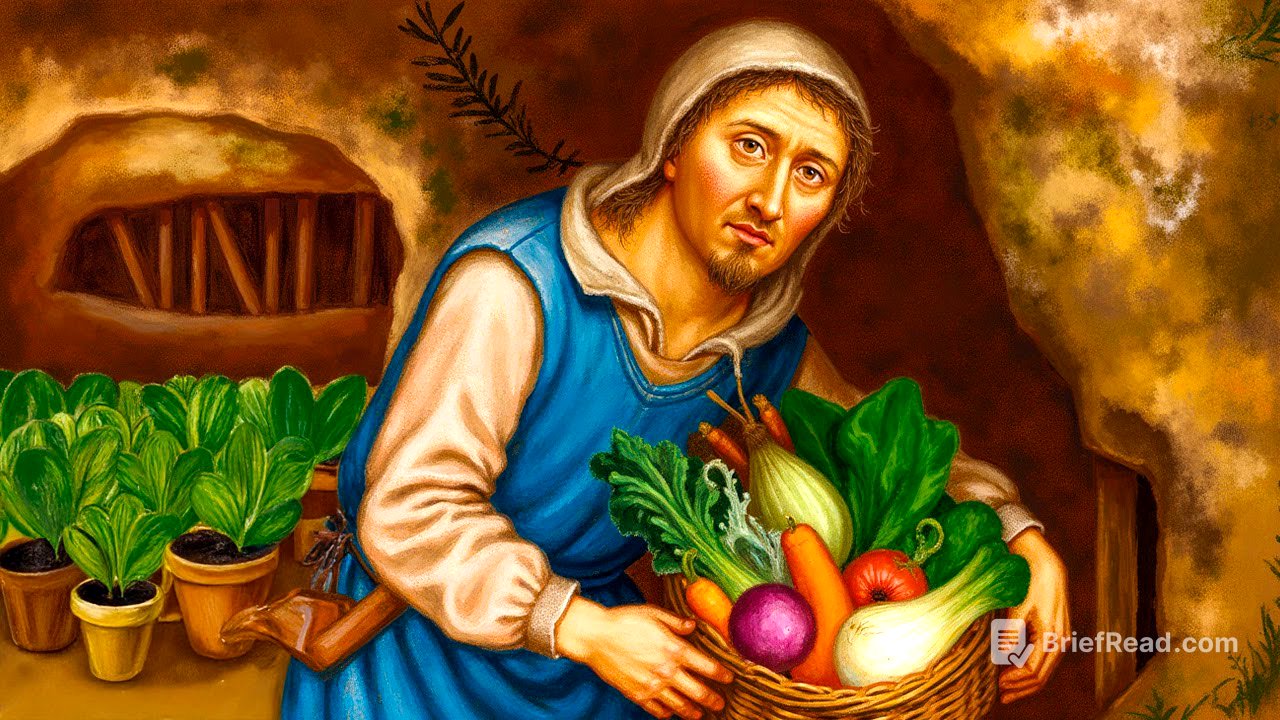TLDR;
This video explores the ingenious methods medieval farmers used to cultivate crops in freezing climates. It highlights strategies employed before winter, including deep plowing, manuring, and water management. The video also covers the selection of hardy plants like rye and cabbage, techniques for creating warmth using manure hotbeds and windbreaks, and the utilization of natural heat sources like stone walls and livestock. Additionally, it discusses seed preservation, the beneficial uses of snow and ice, staggered harvesting, winter gardening, and soil health maintenance through crop rotation and natural fertilizers.
- Preparing for Winter: Deep plowing, manuring, and drainage systems.
- Selecting Hardy Plants: Rye, cabbage, and companion planting.
- Creating Warmth: Manure hotbeds, windbreaks, and cloches.
- Utilizing Natural Heat: Stone walls, south-facing slopes, and livestock.
- Seed Preservation: Drying, storing in clay pots, and root cellars.
- Winter's Benefits: Snow as insulation, ice for irrigation, and frost for soil improvement.
- Harvesting Strategies: Staggered harvesting and frost-enhanced flavors.
- Winter Gardening: Indoor herb gardens, compost heat, and sprouted grains.
- Soil Health: Crop rotation, natural fertilizers, and cover crops.
Preparing for Winter [0:05]
Medieval farmers undertook several crucial tasks before winter to ensure their survival. They began with deep plowing using wooden plows with iron tips pulled by oxen to break up the soil before it froze solid, which helped the soil remain loose and nutrient-rich. Manure was collected from livestock and spread across fields with straw and leaves to keep the soil warmer, sometimes by as much as 10 degrees, and to provide nutrients as it decomposed. Water management was also essential, with farmers digging networks of ditches to drain excess water away from fields, preventing the soil from becoming waterlogged and freezing, which could kill young plants. The timing of these preparations often followed specific patterns based on seasons and moon phases, with some believing that land prepared during a waning moon would yield better harvests.
Selecting Hardy Plants [2:17]
Medieval farmers carefully selected plants that could withstand freezing temperatures. Winter grains, particularly rye, were vital as rye could grow in colder conditions than other grains. Rye seeds were planted in late autumn to lie dormant under the snow and begin growing as soon as temperatures rose in spring, providing extra growing time. Tough vegetables like turnips, cabbages, and onions were also essential, planted in late summer to mature before the first hard freeze. Cabbage was especially useful, offering multiple meals and the ability to be preserved as sauerkraut. Companion planting, such as growing beans and peas with grains, was another clever method, with the climbing plants supporting the grains and adding nutrients to the soil. Planting short crops between taller ones also helped protect fragile plants from harsh winds, increasing harvest yields by up to 25%.
Creating Warmth [4:33]
Medieval farmers developed innovative methods to protect their crops from freezing temperatures. Manure hotbeds were created by digging shallow trenches, filling them with fresh animal waste, and adding a thin layer of soil on top. The decomposing waste could warm the soil by up to 15 degrees for several weeks, preventing roots from freezing. Wind protection was achieved by creating windbreaks called waddles, weaving flexible branches into fences to block harsh winds while allowing sunlight to reach the plants, increasing food production by nearly 30%. Early versions of greenhouses, called cloches, were crafted from glass or clay and placed over individual plants to trap heat, while cold frames, wooden boxes with transparent tops, protected entire rows of plants. For important crops, slanted frames covered with oiled parchment allowed sunlight in while keeping cold air out, extending growing seasons by up to 40 days.
Utilizing Natural Heat [6:38]
Medieval farmers expertly used natural heat sources to aid their crop growth. South-facing stone walls were used to plant delicate crops, as the walls absorbed sunlight during the day and released stored heat at night, creating a warmer microclimate. In colder regions, curved stone walls were built to focus this heat effect, creating pockets where frost-sensitive plants could survive. Field placement was carefully planned based on the sun's path, with south-facing slopes receiving up to 40% more sunlight, reserved for the most important or vulnerable crops. Gardens were strategically placed near livestock pens, as the animals' body heat warmed the surrounding air, with a large barn housing 20 cows able to raise the air temperature in adjacent areas by as much as 4 degrees on cold nights. Some communities built living quarters and animal shelters on the north side of garden plots to provide a windbreak and allow heat from daily activities to benefit food production, with smoke vents from cooking fires directed under raised growing beds to provide warmth to plant roots.
Seed Preservation [9:00]
Medieval farmers employed effective methods to preserve seeds and plant materials for future growing seasons. Seeds were dried properly by spreading them on cloth in warm, sunny places until completely dry to prevent rot or premature sprouting. Dried seeds were stored in clay pots, which kept out mice and insects while allowing enough air to prevent mold, maintaining steady humidity levels to keep seeds alive for years. Some villages added herbs like tansy to their seed storage to repel bugs. Underground cellars or rooms dug into hillsides provided cool temperatures just above freezing, with some seed storage rooms maintaining temperature changes within 5 degrees all year. Root vegetables for replanting were packed in slightly damp sand inside wooden barrels or stone-lined pits dug below the frost line to prevent drying out and rot. Small herbs were often potted and brought inside homes or monasteries to survive until spring, providing fresh seasonings and ensuring new plants for the next growing season.
Winter's Benefits [11:07]
Medieval farmers discovered ways to harness the benefits of winter cold, turning problems into solutions. Snow acted as a natural blanket for planted fields, protecting dormant plants from colder air, with temperatures under the snow up to 30 degrees warmer than the exposed air. Winter wheat and rye benefited from this snow protection, with snow-covered fields growing 20% more grain than exposed fields. Clever water management using ice involved creating shallow pools in autumn that would freeze during winter, providing steady water to nearby fields as the ice melted in early spring. The freezing and thawing cycle also improved difficult soil, with heavy clay soils becoming easier to manage after winter freezes broke them apart, reducing spring planting work by as much as 40%. Winter barley fields made direct use of snowmelt, with seeds planted just before the first snowfall to stay dormant and sprout quickly when temperatures rose and snow melted, providing protection against spring dry spells.
Harvesting Strategies [13:46]
Medieval farmers used staggered harvesting to maximize their yields. Instead of gathering everything at once, they picked crops in carefully planned stages, with early harvests beginning with quick-growing vegetables and tougher crops staying in the ground longer. Many villages created five or six different harvest zones, each picked at specific times based on generations of weather observations. Late-season root crops like turnips and parsnips stayed in the ground until just before hard frost, improving their flavor and storage life, lasting up to 30% longer than those dug up earlier. Frost was also used as a flavor enhancer, with crops like kale and certain cabbages tasting sweeter after experiencing light frost, as the cold caused the plants to convert starches into sugars, improving both taste and nutrition. Timing these harvests required impressive weather knowledge, with communities developing prediction methods based on natural signs, cloud patterns, animal behavior, and onion skin thickness to determine when killing frost would arrive, correctly predicting first frost dates within 5 days over 70% of the time.
Winter Gardening [15:51]
Medieval farmers produced fresh greens even during winter months through various methods. Indoor herb gardens flourished in monasteries, using stone buildings to create protected growing spaces, with kitchens maintaining small herb gardens in south-facing windows where plants like thyme, parsley, and chives could grow year-round. Heated compost gardens created warm growing spaces outdoors, with fresh manure and plant waste generating significant heat as they decomposed, allowing cold-tolerant greens like young kale and certain herbs to grow near these heaps. Sprouted grains provided another source of fresh winter greens, with wheat, barley, and rye sprouted indoors in any container with minimal light, offering considerable nutritional benefits and ready to eat in just 5 to 7 days. Some communities built special growing chambers partially underground, where the earth's natural warmth provided some protection from freezing temperatures, with south-facing rock walls absorbing sunlight during the day and releasing heat at night, creating a mini-greenhouse effect.
Soil Health [18:32]
Medieval farmers maintained soil health through freezing winters using several clever methods. Crop rotation was their main strategy, splitting farmland into three fields and using each one differently each year, with one field left fallow to rest and rebuild its strength, boosting food production by about 1/3 compared to constantly used fields. Natural fertilizers like wood ash from cooking fires and crushed animal bones were added to the soil to provide essential minerals and nutrients. Cover crops, such as clover, were planted after harvest to take nitrogen from the air and store it in their roots, enriching the soil when dug in during spring and preventing topsoil erosion. Marling, digging up chalky clay from deep underground and spreading it on fields, helped balance out sour soil. Sheep and cows became four-legged fertilizer spreaders, grazing on leftover plants and fields after harvest, with farmers using movable fences to ensure even distribution of manure. Green manuring involved intentionally growing a crop just to plow it under while still green, adding nutrients and organic matter to the soil. Winter soil care also included digging trenches to help water drain away, preventing plant roots from freezing and making the ground easier to work in early spring, while snow helped protect soil life, allowing tiny, helpful creatures to survive and keep the soil healthy for spring.









